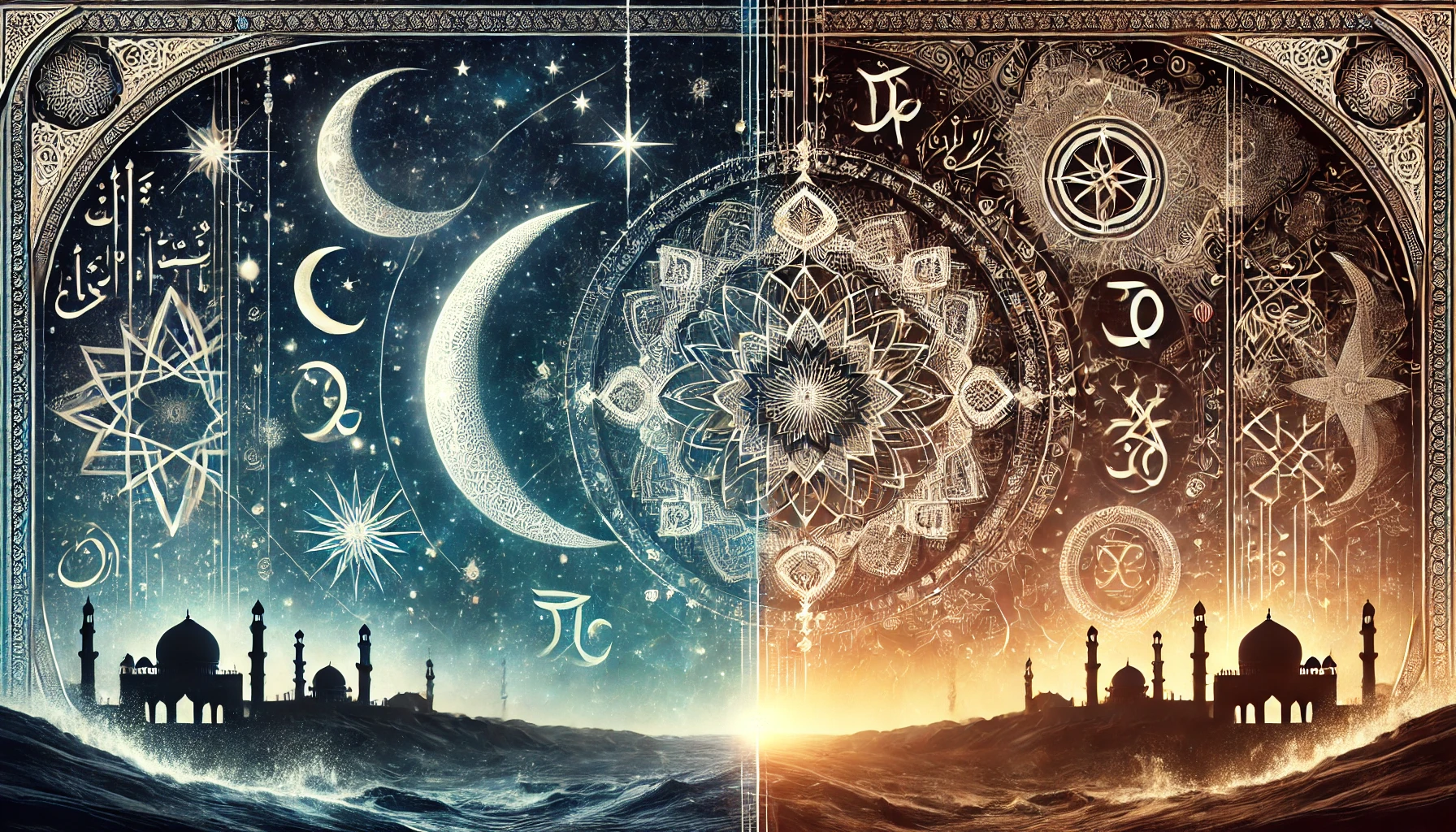The Battle of the Astrologers: Arabic vs Vedic – Who Reigns Supreme?

Introduction
Astrology has always fascinated people, offering insights into personality, relationships, and life events. Two major systems often discussed are Arabic Astrology and Vedic Astrology. While both provide unique perspectives, they come from different cultural and historical backgrounds.
Understanding these differences can enhance your comprehension of astrological signs and provide a richer experience when exploring astrological systems.
Arabic Astrology
Arabic Astrology has its roots in ancient Babylonian practices and was significantly influenced by Greek astrology. This system focuses on:
- Lunar mansions
- Planetary hours
- Fixed stars
It places a strong emphasis on the Moon’s phases and their impact on human affairs.
Vedic Astrology
Vedic Astrology, also known as Jyotish, originates from ancient Indian texts called the Vedas. This system uses a sidereal zodiac and emphasizes:
- The Moon’s position at birth
- Dasha periods to forecast various life stages
In this article, we will:
- Explore the historical backgrounds of both Arabic and Vedic astrology.
- Compare the methodologies and techniques used in each system.
- Examine the core principles that guide Vedic astrology.
- Identify key similarities and fundamental differences between these astrological traditions.
- Gain practical insights into how these systems are applied today.
By exploring “arabic astrology vs vedic astrology,” you can better understand which system resonates with you personally.
Historical Background of Arabic Astrology and Vedic Astrology
Origins and Early Development of Arabic Astrology
Arabic astrology’s roots can be traced back to ancient Babylonian practices and were heavily influenced by Greek astrological traditions. The Babylonians were among the first to systematically observe and record celestial phenomena, laying the groundwork for later astrological systems. When Greek astrology merged with these ancient practices, it brought new techniques and interpretations to the mix. This synergy created a rich tapestry of knowledge that would eventually be adopted and adapted by Islamic scholars.
Role of Lunar Mansions (‘Manazil al-Qamar’)
A distinctive feature of Arabic astrology is its focus on lunar mansions, known as Manazil al-Qamar. The system divides the sky into 28 sections based on the Moon’s monthly journey. Each mansion represents specific attributes and influences:
- 1st Mansion (Al Sharatain): Associated with beginnings and initiations.
- 2nd Mansion (Al Butain): Linked to protection and safety.
These lunar mansions are crucial for making predictions and determining auspicious times for various activities.
Historical Roots of Vedic Astrology
Vedic astrology, also referred to as Jyotish, finds its origins in the ancient Indian texts known as the Vedas. These sacred scriptures lay the foundation for a comprehensive system that places significant importance on celestial bodies’ positions. Jyotish, meaning “the science of light,” aims to illuminate human lives through detailed astrological charts.
Differences in Zodiac Systems
One key difference between Vedic astrology and other forms, including Arabic and Western astrology, is its use of the sidereal zodiac. Unlike the tropical zodiac used in Western astrology, which is fixed relative to the Earth’s seasons, the sidereal zodiac is aligned with actual constellations in the sky. This alignment results in a more astronomically accurate representation of celestial positions at any given time.
In summary:
- Arabic Astrology: Influenced by ancient Babylonian practices and Greek traditions.
- Focuses on lunar mansions (Manazil al-Qamar).
- Emphasizes lunar phases.
- Vedic Astrology: Rooted in ancient Indian texts (the Vedas).
- Uses sidereal zodiac.
- Places significant importance on Jyotish principles.
Both systems offer unique methodologies for understanding celestial influences on human affairs, each bringing its own historical richness and cultural nuances to the field of astrology.
Methodologies and Techniques: A Comparative Study
Arabic Astrology
1. Moon Phases Influence
Arabic astrology places significant emphasis on the phases of the Moon. The lunar cycle, divided into 28 mansions known as Manazil al-Qamar, serves as a key framework for understanding celestial influences. Each mansion corresponds to specific attributes and impacts various aspects of life, from personal relationships to agricultural practices. For instance, certain phases are considered more favorable for initiating new ventures, while others may be linked to introspection and caution.
2. Planetary Hours for Auspicious Timings
Another unique feature in Arabic astrology is the use of planetary hours. A day is divided into segments ruled by different planets, each bringing its own set of influences. By determining which planet governs a particular hour, astrologers can identify auspicious timings for activities such as business transactions, travel, or medical treatments. This technique allows for precise planning based on the celestial schedule.
3. Fixed Stars Role in Predictions
Fixed stars also play an integral role in Arabic astrological predictions. The positions of these stars at any given time can offer insights into future events and individual destinies. Astrologers analyze their alignments with other celestial bodies to make detailed forecasts. For example, the star Aldebaran is often associated with wealth and honor, while Antares might signify challenges and transformation.
Vedic Astrology
Vedic astrology shares some methodological similarities but diverges in several key areas.
1. Lunar Charts (Janam Kundali)
Vedic astrology gives paramount importance to the position of the Moon at the time of birth. Lunar charts or Janam Kundali form the foundation for many readings. Comparing these charts with current planetary positions allows astrologers to provide tailored advice on personal growth, career prospects, and relationship dynamics.
2. Dasha Periods
A distinctive aspect of Vedic astrology is the concept of Dasha periods—planetary periods that govern different phases of an individual’s life. Each Dasha brings its own set of challenges and opportunities, helping individuals understand their karmic path and make informed decisions.
3. Comprehensive Birth Chart Analysis
When interpreting birth charts, Vedic practitioners consider a multitude of factors: planetary placements, aspects, transits, and more. This holistic approach ensures a comprehensive analysis that integrates various elements to provide accurate predictions and guidance.
By examining these methodologies side by side, you can appreciate the unique techniques each system employs while recognizing their shared emphasis on lunar influences and celestial timings.
Core Principles of Vedic Astrology: An In-Depth Look
Position of the Moon and Janam Kundali
In Vedic astrology, the Moon’s position at the time of an individual’s birth is extremely important. The Moon’s placement is used to create a lunar chart known as the Janam Kundali, which serves as a foundational tool for accurate readings. Unlike solar charts that dominate Western astrology, the Janam Kundali provides unique insights into an individual’s emotional and mental state, determining their natural tendencies and potential life path.
Dasha System Explanation
The Dasha system is another key aspect of Vedic astrology. This predictive framework divides a person’s life into distinct periods ruled by different planets. Each Dasha period has its characteristics, influencing various life aspects such as career, relationships, and health. The sequence and duration of these periods are calculated based on the Moon’s position in the Janam Kundali. For example, someone in their Rahu Dasha might experience sudden changes and upheavals compared to a more stable period under Jupiter’s influence.
Birth Chart Analysis Approach
Interpreting a birth chart in Vedic astrology is a comprehensive task. Practitioners consider multiple factors:
- Planetary placements: The positions of planets at birth influence different aspects of life.
- Aspects: How planets interact with each other within the chart offers additional layers of meaning.
- Transits: Current planetary movements and their impact on an individual’s natal chart.
This multi-faceted approach allows for nuanced predictions and personalized guidance. By analyzing these elements, astrologers can provide insights into one’s strengths, challenges, and potential future events.
Arabic Astrology vs Vedic Astrology
While both systems share some similarities like the use of lunar mansions (Nakshatras) and celestial influences over human affairs, they differ significantly in methodology and philosophy. Arabic astrology emphasizes lunar phases and specific timings through planetary hours, whereas Vedic astrology integrates a broader range of principles including karmic implications and spiritual growth via the Dasha system.
Key Similarities Between Arabic and Vedic Astrology Systems
Both Arabic and Vedic astrology emphasize the importance of lunar mansions within their frameworks. In Arabic astrology, these are known as ‘Manazil al-Qamar,’ while in Vedic astrology, they are referred to as ‘Nakshatras.’ These lunar mansions serve as crucial markers for interpreting celestial influences on human affairs. Each Nakshatra or Manzil al-Qamar is associated with specific attributes, helping astrologers make nuanced predictions.
Another significant similarity is the emphasis on celestial influences rather than deterministic outcomes. Both systems view the positions and movements of celestial bodies as influential factors that shape human experiences and events. This approach allows for a more fluid understanding of potential outcomes, steering away from rigid determinism.
This shared philosophy offers a more holistic approach to astrology, encouraging a broader perspective when analyzing astrological charts.
Key Differences Between Vedic and Arabic Astrology
Philosophical Foundations
Vedic astrology places a significant emphasis on karmic influences. This system operates on the principle that the positions of celestial bodies at the time of your birth reflect karmic imprints from past lives, which influence your present and future experiences. The concept of karma is integral, guiding practitioners to understand life events as part of a broader spiritual journey.
Arabic astrology, in contrast, centers more on timing considerations. It focuses on the Moon’s phases and positions within the 28 lunar mansions (Manazil al-Qamar) to determine the most auspicious times for various activities. The philosophical framework here is less about spiritual growth and more about practical timing for success in daily endeavors.
Zodiac Systems
- Vedic Astrology: Utilizes the sidereal zodiac, which aligns with the actual constellations.
- Arabic Astrology: Often incorporates elements from Greek astrology, blending it with lunar cycles and fixed stars.
Predictive Techniques
In Vedic astrology, detailed predictions are derived from complex calculations involving planetary placements, aspects, transits, and Dasha periods. These Dasha periods correspond to different phases of your life, offering insights into how various planetary influences will manifest over time.
Arabic astrology employs predictive techniques that focus more narrowly on lunar phases and planetary hours, providing immediate guidance for specific questions or dilemmas. This method often relies on the positions of fixed stars to enhance accuracy in timing.
“The difference in focus—karmic implications in Vedic versus timing considerations in Arabic—defines their unique approaches.”
Practical Insights into How They are Used Today
Horary Techniques for Specific Questions
Horary astrology is prominent in both Arabic and Vedic traditions, providing precise answers to specific questions. When you consult an astrologer skilled in these methods, the exact time and place of your question become crucial. This snapshot of the cosmos provides insights tailored to your immediate needs.
Arabic Astrology
- Focus on Timing: Arabic astrology excels in determining auspicious times for actions like business ventures or personal undertakings. By analyzing planetary hours and the positions of fixed stars, astrologers can guide you on when to proceed or hold back.
- Manazil al-Qamar: The 28 lunar mansions play a pivotal role. Each mansion corresponds to particular activities or events, helping you align your plans with celestial influences.
Vedic Astrology
- Dasha System: Vedic astrology uses the Dasha system to outline phases in your life, offering a comprehensive view of your karmic path. This method helps pinpoint when specific events are likely to occur, giving you foresight into major life changes.
- Nakshatras: Similar to Arabic astrology’s lunar mansions, Nakshatras in Vedic practice help determine the best times for various activities. The Moon’s position within these Nakshatras can provide detailed guidance on personal and spiritual matters.
When comparing Arabic astrology vs Vedic astrology, each offers unique tools for navigating life’s challenges. Whether you’re seeking precise timing or understanding broader life phases, both systems provide valuable insights tailored to your needs.
Conclusion: Exploring Your Astrological Path Forward
Understanding Arabic astrology and Vedic astrology offers a wealth of insights and methods. Each tradition has its own unique view, influenced by culture and history.
- Arabic Astrology: Focuses on lunar phases, planetary hours, and fixed stars.
- Vedic Astrology: Concentrates on lunar charts, Dasha periods, and karmic implications.
Your astrological journey is personal. Explore both systems to discover which one resonates most with you. This comparison will help you decide between Arabic astrology and Vedic astrology. Engaging deeply with either or both can provide profound guidance in navigating life’s complexities.
“Astrology is a language. If you understand this language, the sky speaks to you.” – Dane Rudhyar
Dive deeper into these traditions. This empowers you to make an informed choice that aligns with your beliefs and needs.
FAQs (Frequently Asked Questions)
What is the main difference between Arabic astrology and Vedic astrology?
The primary distinction lies in their philosophical foundations; Vedic astrology emphasizes karmic influences and uses a sidereal zodiac, while Arabic astrology focuses more on timing considerations and lunar mansions.
How do lunar mansions play a role in both astrological systems?
Both Arabic and Vedic astrology utilize lunar mansions (Nakshatras) as significant markers within their frameworks, indicating the influence of the Moon’s position on human affairs.
What methodologies are employed in Arabic astrology?
Arabic astrology employs various methodologies, including the influence of moon phases on human affairs, the use of planetary hours for determining auspicious timings, and the role of fixed stars in predictions.
What is a Janam Kundali and why is it important in Vedic astrology?
A Janam Kundali is a birth chart that highlights the position of celestial bodies at an individual’s time of birth. It is crucial for accurate readings as it serves as a foundational tool for interpreting one’s life path in Vedic astrology.
How are horary techniques used in Arabic astrology?
Horary techniques in Arabic astrology are utilized to answer specific questions or dilemmas faced by individuals. Astrologers trained in this method provide guidance based on the positions of celestial bodies at the time the question is posed.
Why is it important to understand different astrological systems?
Understanding different astrological systems, such as Arabic and Vedic astrology, allows individuals to explore various perspectives on celestial influences, which can help them choose an astrological path that resonates most strongly with their personal beliefs and experiences.








Connect me